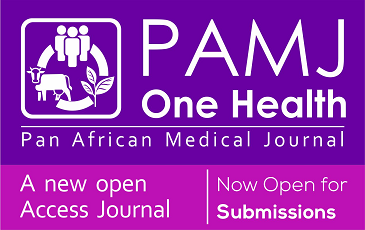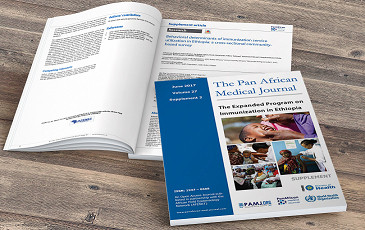Prenatal genetic diagnosis of a high-risk Morquio A syndrome foetus: a rare case report and literature review
Ghada Abdelmoula, Aymen Khalfaoui, Ibtissam Lakmali, Nairouz Mtir, Houssem Ragmoun
Corresponding author: Ghada Abdelmoula, Regional Hospital of Menzel Temime, Department of Gynecology and Obstetrics, 8080, Menzel Temime Nabeul, Tunisia 
Received: 14 Apr 2024 - Accepted: 27 May 2024 - Published: 05 Jun 2024
Domain: Genetics, Gynecology, Obstetrics and gynecology
Keywords: Genetic testing, mucopolysaccharidosis IV, N-acetylgalactosamine-6-sulfatase (GALNS), Morquio A, prenatal diagnosis, case report
©Ghada Abdelmoula et al. PAMJ Clinical Medicine (ISSN: 2707-2797). This is an Open Access article distributed under the terms of the Creative Commons Attribution International 4.0 License (https://creativecommons.org/licenses/by/4.0/), which permits unrestricted use, distribution, and reproduction in any medium, provided the original work is properly cited.
Cite this article: Ghada Abdelmoula et al. Prenatal genetic diagnosis of a high-risk Morquio A syndrome foetus: a rare case report and literature review. PAMJ Clinical Medicine. 2024;15:15. [doi: 10.11604/pamj-cm.2024.15.15.43624]
Available online at: https://www.clinical-medicine.panafrican-med-journal.com//content/article/15/15/full
Case report 
Prenatal genetic diagnosis of a high-risk Morquio A syndrome foetus: a rare case report and literature review
Prenatal genetic diagnosis of a high-risk Morquio A syndrome foetus: a rare case report and literature review
![]() Ghada Abdelmoula1,2,&, Aymen Khalfaoui1,2, Ibtissam Lakmali1,3, Nairouz Mtir1,4, Houssem Ragmoun1,2
Ghada Abdelmoula1,2,&, Aymen Khalfaoui1,2, Ibtissam Lakmali1,3, Nairouz Mtir1,4, Houssem Ragmoun1,2
&Corresponding author
Morquio A disease, also known as mucopolysaccharidosis type IV (Morquio A syndrome or MPS IVA), is a rare autosomal recessive disease that affects multiple systems and can be life threatening. It is caused by a deficiency of the lysosomal enzyme N-acetylgalactosamine-6-sulphate sulphatase (GALNS), which is responsible for the degradation of keratan sulphate (KS) and chondroitin-6-sulphate (C6S). The disease is characterised by pulmonary and respiratory manifestations, as well as bone involvement, resulting in progressive spondyloepimetaphyseal damage. Later on, ophthalmological, auditory, and cardiac complications may occur. This case report presents Mrs. MS, a 33-year-old woman with no notable medical history, who came to our clinic for pregnancy follow-up. Her first pregnancy in 2015 was uneventful, and the result of a nonconsanguineous marriage, free of dysgravidia. A female newborn weighing 4,000g was delivered vaginally. At the age of 2 years, she was diagnosed with Morquio disease type A due to severe growth retardation and osteoarticular deformities. The patient had expressed concerns about her new pregnancy, and a prenatal molecular diagnosis of Morquio disease was proposed. The diagnosis was made in amniotic fluid collected by amniocentesis at 16 weeks of gestation. The molecular study and analysis of the GALNS gene confirmed that Mrs. MS fetus was affected by Morquio disease type A. After a multidisciplinary antenatal consultation and with informed consent, the parents decided to terminate the pregnancy due to medical reasons. Genetic counseling plays a crucial role in this autosomal recessive disorder, and molecular diagnostics allow couples to choose the prenatal diagnosis if they wish. This condition may not be well understood by gynecologists. Therefore, it is important to report our clinical case and describe some clinical aspects of this syndrome while clarifying prenatal diagnostic methods.
Mucopolysaccharidoses (MPS) are overload diseases linked to the defective functioning of enzymes responsible for the degradation of glycosaminoglycans (GAGs), and whose symptomatology is the consequence of the accumulation of these GAGs in various tissues and organs. These are catalytic enzymes of the lysosome, intracytoplasmic organelles responsible for the renewal of cellular components [1]. Morquio A disease, also known as mucopolysaccharidosis type IV (Morquio A syndrome; MPS IVA), was first described in 1929 by Luis Morquio, a paediatrician in Uruguay, as a 'familial form of bone dystrophy [2]'. James Brailsford, an English radiologist [3], also described it as 'osteochondrodystrophia deformans.’ This metabolic bone disorder is caused by a deficiency of the enzyme N-acetylgalactosamine-6-sulphate sulphatase (GALNS), which is responsible for the degradation of keratan sulphate (KS) and chondroitin-6-sulphate (C6S). KS accumulates in cartilage and the eye, but it is unclear how this accumulation leads to bone abnormalities.
The disorder is rare and is inherited in an autosomal recessive manner, with an estimated prevalence of 1 in 250,000 births. Inter-regional differences have been observed in the incidence of MPS IVA. For example, in Ireland, the incidence is 1/76,000 births [1], while in Australia it is 1/640,000 births [1]. Mucopolysaccharidosis type IV (MPS IVA) is caused by mutations in the gene that codes for GALNS [1]. To date, more than 180 mutations have been described, which may partly explain the clinical variability of this condition. Certain mutations have been shown to have genotype-phenotype correlations.
Patient information: MRS. MS, a 33-year-old woman with no significant medical history, came to our clinic for pregnancy follow-up. She is Gravida 2 Para 1. Her first pregnancy in 2015 was uncomplicated, resulting from a non-consanguineous marriage and free of dysgravidia. She delivered a female newborn weighing 4,000 g vaginally. At the age of 2, the child was diagnosed with Morquio disease type A after experiencing severe growth retardation and osteoarticular deformities.
Timeline of the current episode and diagnostic assessment: the patient expressed concern regarding her new pregnancy. A prenatal molecular diagnosis of Morquio disease was suggested based on amniotic fluid collected by amniocentesis at 16 weeks of gestation.
Diagnosis: the results of the molecular study and the analysis of the GALNS gene confirmed that the fetus of Mrs. MS. was affected by Morquio disease type A.
Follow-up and outcome of the interventions: a morphological ultrasound performed at 20 weeks of gestation revealed an overlap of skull bones at the occipital level, a low cardiothoracic index indicating thoracic enlargement (Figure 1), and discrete subcutaneous edema. The rest of the morphological study did not reveal any anomalies. Following antenatal diagnostic staff and informed consent, the parents chose to terminate the pregnancy. The patient underwent cervical ripening using a Foley catheter and misoprostol (400 microgrammes sublingually every 3 hours). Subsequently, the patient expelled a female fetus (Figure 2), and due to placental retention, digital curettage combined with ultrasound-guided aspiration under general anesthesia was necessary. Follow-up was uneventful, both clinically and biologically, and the patient was discharged after receiving Cabergoline to inhibit lactation.
Patient perspective: the patient thought that a turning point was reached when a fetal molecular diagnosis was received. Clarity and direction were provided during a time of uncertainty. The genetic anomaly was discovered through this advanced testing, explaining the potential health issues for the unborn child. Informed decisions were made, and better preparation for the future was achieved.
Informed consent: the patient gave informed consent.
The incidence of MPS IVA is estimated at 1 in 105 births in Japan, 0.46 in 105 births in Colombia, and 1.3 in 105 births in Northern Ireland. Studies carried out in Tunisia have shown the relative frequency of this type of pathology. The prevalence of this disease in children living in central and southern Tunisia, between 2 and 8 years of age, is estimated at 2.8 out of 105 births [4]. In a study conducted in Tunisia [4], it was found that all patients with MPS IVA studied were the offspring of consanguineous marriages. In fact, in the Tunisian population, consanguineous marriages of all degrees represent more than 32% of all marriages but can reach 60% in rural areas of the country. This type of social and cultural tradition probably favours exposure to rare mutations involved in certain serious diseases, such as Morquio A disease. Interestingly, our case report involves a pregnancy resulting from a non-consanguineous marriage, where the parents had no family relationship. This contradicts the expected outcome.
The clinical heterogeneity of Morquio disease, particularly in terms of severity, has long been emphasised. Severity is classically determined by the age of onset of symptoms. A distinction is made between (i) severe forms (first signs before 1 year of age, sometimes from birth); (ii) intermediate forms (between 1 and 5 years of age); (iii) slowly progressive forms (first signs late, sometimes after 20 years of age) [5]. A study of the initial presentation of 326 patients included in the International Morquio A Registry in 2007 revealed that 32% of the patients had symptoms before the age of one, 40% between the ages of one and three, 18% between the ages of three and five, and 9% after the age of five. The same study also found that 9% were diagnosed before the age of 1 and 8% after the age of 10 [6].
In 2013, Hendriksz conducted a very precise analysis of the same International Morquio Registry extended to 399 patients and found that 3/4 of the cases were severe. The study reported a mean age of symptom onset of 2.2 years and a mean age of diagnosis confirmation of 4.9 years [1]. In general, the telltale signs are bony deformities, particularly a deformity of the thorax with anterior protrusion of the sternum or carina thorax (pectus carinatum), and/or gait disorders. Static disorders of the lower extremities or statural inflection may also be telltale signs. Malpositioned feet and/or limited hip abduction can be noted from birth, and are often attributed to the disease a posteriori. In classic forms, the signs are completed fairly rapidly, with slowing of statural growth, marked shortening of the trunk, and micromelia. The genu valgum is almost constant in this condition. Hyperlaxity of the wrists contrasts with the limitation of the proximal joints, hips, knees, and elbows. An ulnar deviation of the hand and a collapse of the arch of the foot appear rapidly in marked forms. Characteristic morphological features gradually appear, with a flat face, slightly thick features, and protrusion of the lower facial mass. Ophthalmologically, a cloudy appearance of the cornea is noted fairly quickly. Dorsolumbar kyphosis is visible in the sitting position, often as early as 1 year of age. In the MorCAP study ("Morquio A Clinical Assessment Program", a longitudinal, multicenter MOR-001 study of 325 Morquio A patients, which prospectively analyzed patients' bone and extra-bone repercussions on an annual basis), 97% of patients had pectus carinatum, over 90% had an abnormal gait, genu valgum, and a short neck [7]. Kyphoscoliosis is noted in 85% of cases, odontoid hypoplasia in 65%, and 30% have cervical myelopathy [7].
The quantification of glycosaminoglycans (GAGs) in urine is a diagnostic tool that demonstrates elevated excretion of keratan sulphate (KS) and, to a lesser extent, chondroitin-6-sulphate (C6S). The certainty of diagnosis is based on the demonstration of enzyme deficiency, which can be tested in leukocytes and/or skin fibroblasts, as well as in chorionic villi and amniotic fluid in the event of prenatal diagnosis. Enzyme activity can be measured to detect heterozygotes in the family, which is generally reduced. However, there is an overlap between the activities of normal individuals and heterozygotes. Molecular analysis of the gene encoding GALNS, including the identification of the mutation(s) responsible for the disease, enables a precise diagnosis of heterozygotes. It also allows the prenatal diagnosis to search for a recurrence in a couple at risk, as was done in our case, and to investigate phenotype-genotype correlations. This study should be conducted within the framework of a specialised genetic consultation, which will clarify the necessity of genetic counseling and provide support throughout the process. Prenatal diagnosis is reliable and is obtained through chorionic villus biopsy, performed between 11 and 12 weeks of amenorrhea, or through amniocentesis, performed between 16 and 18 weeks of gestation. The diagnosis can be made by determining enzyme activity or by molecular diagnosis if the mutation in the index case has been identified, as in our case [8]. The rapid direct response, which takes 1 to 3 days, must be confirmed by a post-culture study, adding an additional delay of 3-4 weeks.
Complications in MPS IVA are primarily related to osteoarticular damage. The condition is progressive, with symptoms worsening over time. Patients with MPS IVA are at high risk of developing neurological complications due to spinal cord compression. This is caused by a combination of odontoid hypoplasia, incomplete ossification of the anteroposterior arches of the atlas, and GAG deposits in the peridural spaces. These factors are combined with cervical-dorsal kyphosis, which modifies the medullary trajectory, possibly creating a bayonet effect. This increases the risk of atlantoaxial dislocation, spinal cord compression with cervical myelopathy, and consequent tetraparesis, even tetraplegia, and sudden death. It is recommended to undergo a routine spinal cord MRI every two years (or more often, if necessary) throughout the disease [1].
This disease is characterised by a significant slowdown in growth, which can come to a complete halt as early as 6-8 years of age. Montaño et al. extensively studied this aspect in 354 patients and proposed specific growth curves for Morquio A patients [9]. In classic forms, inflection occurs around 1 year of age, with patients reaching adult height at 11 years for boys and 9 years for girls. The final heights of adults are 113.1 ± 22.6 cm in girls and 122.4 ± 21.5 cm in boys. The authors also observed that 5 to 7% of patients became overweight after the age of 18, which further worsened their osteoarticular condition. This excess weight is more prevalent in patients using wheelchairs. Patients with MPS IVA often experience ocular involvement, with corneal opacification being the primary symptom. However, in some cases, the retina may also be affected [1]. Corneal grafting is a common treatment for severe corneal damage, which generally yields positive results. Nevertheless, opacification may recur on the graft.
As the disease progresses, patients may develop cardiac and lung complications, even those with a less severe form of the disease. Echocardiography typically shows thickening of the heart valves, accompanied by aortic and mitral regurgitation. Mucopolysaccharidosis type IV (MPS IVA) patients also frequently experience repeated upper airway infections and deafness, necessitating close monitoring by an ear, nose, and throat (ENT) specialist. Patients with MPS IV have a multifactorial pulmonary restrictive syndrome, with pectus carinatum being the primary cause. Thickened mucous membranes and poor drainage of secretions result in frequent bronchopulmonary infections. As with other mucopolysaccharidoses, a specialised multidisciplinary team, including orthopedic surgeons, neurosurgeons, ENT specialists, cardiologists, pulmonologists, physiotherapists, and occupational therapists, must provide symptomatic management. The aim is to alleviate the various complications. The most frequent surgeries performed in MPS IVA include routine procedures (tonsillectomy, adenoidectomy, insertion of transtympanic aerators) and more complex procedures (spinal cord decompression, cervical arthrodesis, femoral, and tibial osteotomies to correct orthopedic deformities, corneal graft, valvuloplasty) [1].
Furthermore, providing educational and rehabilitative support for these children and their families, along with implementing adaptive and preventive measures for their disabilities, is crucial for patient follow-up. The recent development of elosulfase alfa, a recombinant enzyme (rhGALNS), which has just received US marketing authorisation, aims to enhance the clearance of keratan sulphate from the lysosome and improve primary symptoms [1]. The mechanism of action of elosulfase alfa is to provide enzymatic activity that reduces the enzyme deficiency caused by MPS IVA. It is identical in sequence and enzymatic activity to the human form of GALNS. Elosulfase alfa has the potential to improve patient endurance, pulmonary function, and quality of life [10] However, in Tunisia, due to limited resources, prenatal diagnosis remains the only option available to at-risk couples. It can be carried out by molecular biology DNA analysis, whenever the mutation affecting the GALNS gene is previously known in the family.
The search for mutations involved in the GALNS gene and the functional study of these molecular lesions remain the strategies generally followed in the absence of satisfactory treatment for Morquio A disease. This allows the establishment of the phenotype/genotype correlation of MPS IVA and provides a reliable prenatal diagnosis for families at risk.
The authors declare no competing interest.
All the authors have read and agreed to the final manuscript.
Figure 1: low cardiothoracic index indicating thoracic enlargement on morphological ultrasound
Figure 2: post-abortum appearance: radiology did not reveal abnormalities
- Baujat G, Valayannopoulos V. Histoire naturelle de la mucopolysaccharidose IV de type A (maladie de Morquio A). Archives de Pediatrie. 2014 Jun 1;21:S32-8. PubMed | Google Scholar
- Morquio L. Sur une forme de dystrophie osseuse familiale. Bull Soc Pediatr Paris. 1929;27:145-52. Google Scholar
- Brailsford JF. Chondro-osteo-dystrophy: Roentgenographic & clinical features of a child with dislocation of vertebrae. The American Journal of Surgery. 1929 Sep 1;7(3):404-10. Google Scholar
- Khedhiri S, Chkioua L, Ferchichi S, Miled A, Laradi S. Morquio A disease: clinical and molecular study of Tunisian patients. Ann Biol Clin. 2011;69(4):425-9. PubMed | Google Scholar
- Hendriksz CJ, Harmatz P, Beck M, Jones S, Wood T, Lachman R et al. Review of clinical presentation and diagnosis of mucopolysaccharidosis IVA. Mol Genet Metab. 2013 Sep-Oct;110(1-2):54-64. PubMed | Google Scholar
- Montaño AM, Tomatsu S, Gottesman GS, Smith M, Orii T. International Morquio A Registry: clinical manifestation and natural course of Morquio A disease. J Inherit Metab Dis. 2007 Apr;30(2):165-74. PubMed | Google Scholar
- Harmatz P, Mengel KE, Giugliani R, Valayannopoulos V, Lin SP, Parini R et al. The Morquio A Clinical Assessment Program: baseline results illustrating progressive, multisystemic clinical impairments in Morquio A subjects. Mol Genet Metab. 2013 May;109(1):54-61. PubMed | Google Scholar
- Bouzidi H, Khedhiri S, Laradi S, Ferchichi S, Daudon M, Miled A. La Mucopolysaccharidose IVA (syndrome de Morquio A) : aspects clinique, biologique et thérapeutique. Ann Biol Clin (Paris) Ann Biol Clin (Paris). 2007 Jan-Feb;65(1):5-11. PubMed | Google Scholar
- Montaño AM, Tomatsu S, Brusius A, Smith M, Orii T. Growth charts for patients affected with Morquio A disease. Am J Med Genet A. 2008 May 15;146A(10):1286-95. PubMed | Google Scholar
- Lee CL, Chuang CK, Chiu HC, Tu RY, Lo YT, Chang YH et al. Clinical Utility of Elosulfase Alfa in the Treatment of Morquio A Syndrome. Drug Des Devel Ther. 2022 Jan 10;16:143-154. PubMed | Google Scholar
Search
This article authors
On Pubmed
On Google Scholar
Citation [Download]
Navigate this article
Similar articles in
Warning: file_get_contents(): SSL operation failed with code 1. OpenSSL Error messages: error:0A000126:SSL routines::unexpected eof while reading in /home/panafric/panafrican-med-journal.com/content/article/index_article_common.php on line 546
Warning: file_get_contents(): SSL: Success in /home/panafric/panafrican-med-journal.com/content/article/index_article_common.php on line 546






